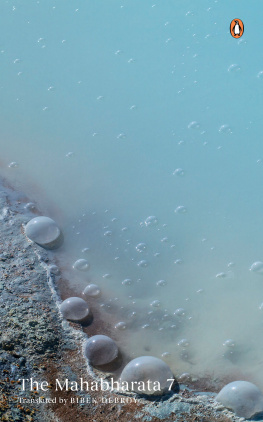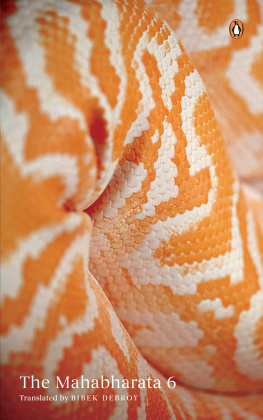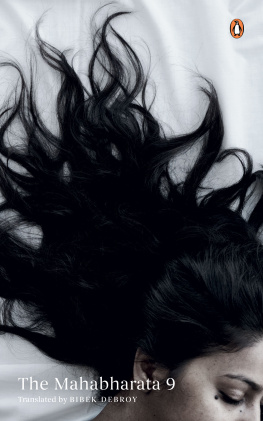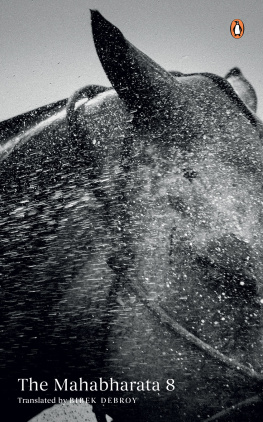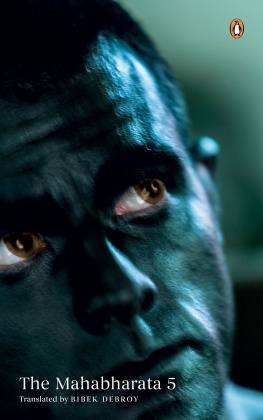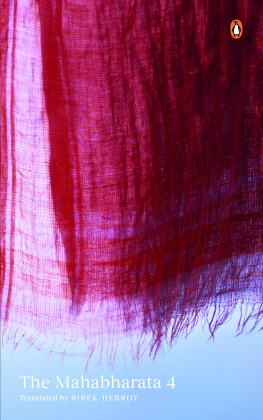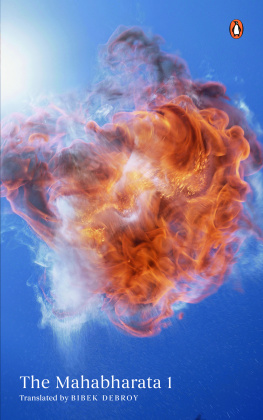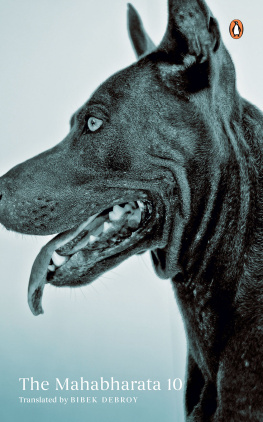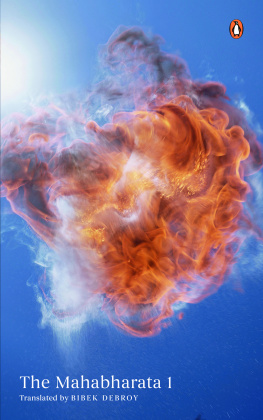Table of Contents

MAHBHRATA
UNRAVELLED
MAHBHRATA
UNRAVELLED
Lesser-Known Facets of a Well-Known History
AMI GANATRA

BLOOMSBURY INDIA
Bloomsbury Publishing India Pvt. Ltd
Second Floor, LSC Building No. 4, DDA Complex, Pocket C 6 & 7,
Vasant Kunj, New Delhi, 110070
BLOOMSBURY, BLOOMSBURY INDIA and the Diana logo are trademarks of Bloomsbury Publishing Plc
First published in India 2021
This edition published 2021
Copyright Ami Ganatra, 2021
Ami Ganatra has asserted her right under the Indian Copyright Act to be identified as the Author of this work
All rights reserved. No part of this publication may be reproduced or transmitted in any form or by any means, electronic or mechanical, including photocopying, recording or any information storage or retrieval system, without the prior permission in writing from the publishers
This book is solely the responsibility of the author and the publisher has had no role in the creation of the content and does not have responsibility for anything defamatory or libellous or objectionable
Bloomsbury Publishing Plc does not have any control over, or responsibility for, any third-party websites referred to or in this book. All internet addresses given in this book were correct at the time of going to press. The author and publisher regret any inconvenience caused if addresses have changed or sites have ceased to exist, but can accept no responsibility for any such changes
ISBN: PB: 978-93-54351-27-3; eBook: 978-93-54351-33-4
Created by Manipal Digital
To find out more about our authors and books visit www.bloomsbury.com and sign up for our newsletters
Contents
Indic knowledge systems clearly differentiate between mythology and history. The Mahbhrata and Rmyana have been called itihsa (iti ha sa: thus it has been), the history of our ancestors. Rmyana, as we know, is composed by Rishi Vlmiki, a contemporary of Shri Rma. Mahbhrata has been immortalised for us by the man who was biologically related to the involved stakeholdersthe Kauravas and the PndavasRishi Veda Vysa. There cannot be a more unbiased source.
The Mahbhrata is also called the pancham Vedathe fifth Veda. By way of historical narration, it provides a framework for understanding and dealing with our own ethical dilemmas. The raw emotions and motivations, the dharma sankatas, faced by the people in the Mahbhrata are so relatable and real that even 5,000 years later, or 7,000 as per some recent estimates, it continues to inspire authors, artists, social scientists and us. The number of works in the mythological fiction genre that get written inspired by the Mahbhrata, even today, is a testimony to its relevance.
The popularity of the epic can be further gauged from off-the-charts viewership of a recent rerun of B.R. Chopras Mahabharat, an old TV series with not-so-sophisticated production by current standards. Even today, we have deep discussions regarding the people in the epic, their personalities and their actions. We have our favourite personalities. The level of our involvement with them is such that discussions often tend to get really passionate. We stand up for them like we would for our friends and relatives. And why not? It is a story of our ancestors, after all.
The original work is in Sanskrit and huge, spanning over 100,000 verses, making it practically impossible for mass consumption except by way of visual storytelling and abridged versions. There are some very good abridged versions but they too are rather big. There is only so much a story of such a large volume can be abridged. To some extent, this gap has been filled by TV series as well as numerous reimagined works based on the text. Even then, a mainstream TV series cant cover all of what is in there.
The adaptations and reimagined fictional works have an element of artistic liberty in different proportions. Sometimes, the artists imaginations are so interesting that a reader begins to assume that as the real story. With the Mahbhrata, given its popularity, and many related works, some imagined stories seem to have become the truth. Misplaced facts give rise to misplaced conclusions. That is why, for a story of such prominence and influence, it is even more important to know the facts as they were told by Veda Vysa, from the authentic sources available to us today.
That is the purpose of this bookto get to know the events and people as told to us by Vysa. By way of the book, I have attempted to shed light on some frequently asked questions, clarify some myths and add not-so-well-known nuances of personalities and relationships related to the Mahbhrata, based on the generally accepted authentic sources. Some questions which I have sought to seek answers to are:
Who narrated the version of the Mahbhrata that is known to us today?
Was South India in any way connected to the Mahbhrata?
Was caste the reason for Karnas downfall? Was he always discriminated against because of his caste?
Why was Arjuna given so much limelight and love?
Why was Yudhishthira called the Dharmarja?
Who was the best warrior of Kurukshetra?
Why was Draupadi given such an important status in the Mahbhrata, more than any other queen? Do we know anything about her life as a queen?
Were women in those days meek and submissive?
What roles did the sons of the Pndavas play?
What happened after the war ended?
...so on and so forth!
The dialogues between the characters are so rich that they unravel the personality traits of the speakers and the essence of the relationship. I have endeavoured to translate and summarise the dialogues in a way to maintain its original intent, emotion, wisdom and nuance. As the idea was to convey the gist, the translation may not be verbatim. I have added notes in such places where I may have taken the liberty to translate words in more contemporary terms. Where needed, I have added a brief closing commentary to the story.
My introduction to the Mahbhrata was also through the TV series. It got me interested enough to read other works related to or based on the Mahbhrata later in life. The more I read, the more questions I had. The only way to satisfy my curiosity, I realised, was by going to the source and reading what Veda Vysa had to say. As I read, I made notes. In a way, the book is an outcome of those notes. There were just so many aha moments that deciding what to add in here and what to keep for later was quite an exercise.
This book has been divided into several parts, beginning with an overall storyline and sequence of events in the Mahbhrata. This section gives a bullet-point summary of the core story and introduces the main characters. The objective is to bring up to speed a reader not familiar with the story and serve as revision/reference for readers aware of the story.
This is followed by Introduction, which is an essay on dharma, the underlying theme of the epic. There is no exact translation of the word in English. The objective of the essay is to explain the term to the readers in some detail.
The next part sets the context of the historywhen was it narrated, who are the Bhratas and what was the extent of the epics geographical coverage.
This is followed by a section which features stories from the Mahbhrata, although not always in chronological order. I have picked and arranged stories to highlight personalities, relations and interactions. Some stories are not so well known, while others are generally known but have interesting details which may ordinarily not be known. Of course, for those Mahbhrata aficionados who have read the unabridged translations, all of these would be known. For them, the arrangement and choice of the stories might be of interest.

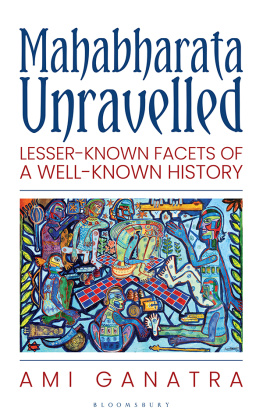
![Krishna Dharma - Mahabharata: [the greatest spiritual epic of all time]](/uploads/posts/book/213378/thumbs/krishna-dharma-mahabharata-the-greatest.jpg)
